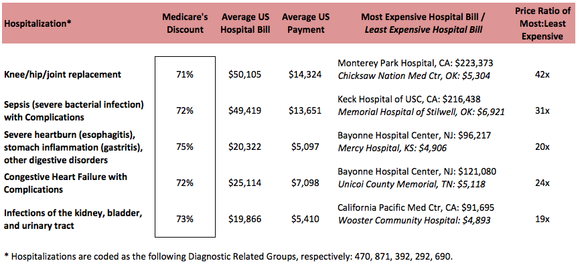By Rich Smith
The Motley Fool, July 21, 2013
The government put a key piece of Obamacare back on the shelf last week, when it announced that companies employing more than 50 workers will have an extra year to begin offering health insurance without facing fines.
Whether you consider this good news or bad news probably depends on whether you were a fan or a foe of the Affordable Care Act in the first place.
But could it be that the ACA isn’t really needed at all? Could an alternative idea — “Medicare for all” — actually do a better job of controlling medical costs, and making health care affordable for Americans?
Obamacare — but cheaper
A new survey released by the number-crunching technocrats at NerdWallet last month clearly illustrates how extending Medicare coverage to all Americans might cut costs for everyone. According to NerdWallet, Medicare generally pays out no more than $0.27 for every dollar that hospitals bill it for medical services — a savings of 73%. Put another way, an uninsured patient receiving the same care as is provided to a patient covered by Medicare can expect to pay nearly four times as much.

And that’s just the average. Echoing the findings of a Time magazine report earlier this year, NerdWallet’s health-care survey noted that the prices charged by various hospitals offering the same procedure can vary widely. As you can see in the far-right column of the pricing chart, you could easily end up paying 30 to 40 times as much for a stay at one hospital than at a hospital down the road, for the same treatment.
Obamacare — but more efficient
How does a 73% discount on medical bills compare to what’s promised under the ACA?
Well, under the current structure, Obamacare works as a plan to require patients to sign up for private health insurance plans. Yet according to Forbes, many of these private insurers offer their members discounts of as little as 20% off hospitals’ ordinary pricing.
One of the standouts, Blue Cross plans from WellPoint (NYSE: WLP ) , is sometimes able to negotiate discounts as large as 60% — still far short of the average discount of 73% with Medicare.
Obamacare — but better
Harvard Medical School visiting professors David Himmelstein and Steffie Woolhandler recently noted on the pages of The New York Times that a Medicare-for-all health care system — known commonly as “single-payer” — is an incredibly efficient operation, in terms of costs.
On average, only 2% of the revenues that flow through Medicare are needed to cover overhead costs. In contrast, patients who subscribe to private health insurance spend 14% of their money — seven times as much — just paying for the overhead costs doctors incur from juggling the multitude of insurance procedures required for different patients subscribing to insurance plans.
Other commenters, such as Dr. Dave Dvorak, writing in the April 2013 issue of Minnesota Medicine, put the cost of Obamacare even higher, arguing that “a staggering 31% of U.S. health care spending goes toward administrative costs, rather than care itself.” As Dr. Dvorak notes, while “Obamacare … is expected to extend coverage to 32 million more Americans,” it does so by “expanding the current fragmented, inefficient system” and is likely to “do little to rein in health-care spending.”
In contrast, the U.S. government itself agrees that the ACA — the system we’ve settled upon instead of offering Medicare for all — costs more than a move to a cheaper, more efficient, and better single-payer system. The U.S. Government Accountability Office calculates that a switch to single-payer would shave $400 billion a year off the national health-care bill.
Little wonder, then, that a 2008 survey published in the Annals of Internal Medicine found that 59% of physicians polled support Medicare for all.
A government takeover?
So Medicare for all is cheaper, more efficient, and better than Obamacare — but isn’t it a “government takeover” of health care?
It needn’t be.
If an individual consumers think they’re better off with a private health insurance plan from WellPoint — or from UnitedHealth Group, Aetna, or Cigna — then fine. They could still sign up for one of those, either as a supplement to Medicare-for-all or, if they prefer, as an exclusive plan, and choose not to participate in Medicare at all. For that matter, there should be no need to require anyone to buy any insurance whatsoever.
All that’s really required for Americans to begin reaping the 73% savings of a Medicare-for-all plan is to open up Medicare enrollment to everybody. Give everyone the right to sign up for Medicare, rather than requiring us all to sign up for a private insurance plan under the ACA. And then let the marketplace decide if Medicare for all is really as good an idea as NerdWallet’s survey makes it sound.
PNHP note: The arrangements described above, namely, the proposed co-existence of private health insurance plans with a Medicare-for-all system, clearly indicate that the author is speaking of a “public option” rather than a single-payer system. Nonetheless, we offer it as further evidence that wide swaths of the U.S. public, including those associated with the financial-services company The Motley Fool, are aware of the compelling evidence in favor of an improved Medicare for all.
http://www.fool.com/investing/general/2013/07/21/how-much-could-medicare-for-all-save-you.aspx#.UevtGUalfbA.email